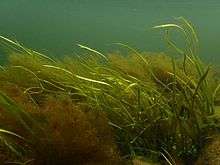Luronium
| Luronium | |
|---|---|
 | |
| Scientific classification | |
| Kingdom: | Plantae |
| (unranked): | Angiosperms |
| (unranked): | Monocots |
| Order: | Alismatales |
| Family: | Alismataceae |
| Genus: | Luronium Raf. |
| Species: | L. natans |
| Binomial name | |
| Luronium natans (L.) Raf. | |
| Synonyms | |
| |
Luronium natans is a species of aquatic plant commonly known as the floating water-plantain. It is the only recognized species in the genus Luronium, native to much of Europe, from Spain to Britain to Norway east to Ukraine.[1][2]
Description
Stems elongated, rising in the water or creeping and rooting at the nodes. Submerged leaves (if present) basal, linear; floating or aerial leaves elliptical to ovate. Flowers hermaphrodite, long-pedunculate in the axils of the floating or aerial leaves. Stamens 6. Carpels 6–15 in an irregular whorl, free, each with 1 ovule; styles apical. Fruitlets achenial, longitudinally many-ribbed, with a short apical beak. 2n = 42.[2][3][4][5]
Ecology
Floating water-plantain grows predominantly in base-poor lakes, ponds and and slow-flowing rivers with low to moderate nutrient levels. In Britain it colonized the canal network during the 19th century and is now well-established there, although it has declined somewhat due to silting up of disused canals and the reopening of other canals to boat traffic, resulting in turbid water. Floating water-plantain seems quite tolerant of acidification, as evidenced by its relative abundance in several Welsh lakes that have suffered severe declines in pH due to acid rain, and also seems able to tolerate moderate water level fluctuation as is seen when certain lakes were converted to reservoirs. Losses have mainly been associated with nutrient enrichment (eutrophication), such as in the Shropshire-Cheshire meres. Declining.
In 2009 it featured on a first class Royal Mail stamp in the series "Endangered Plants".[6] It is said to have "spread eastwards from its core natural habitats in the lakes of Snowdonia and mid Wales in the 19th century, taking advantage of the canal network. In recent decades, however, pollution and recreational boating have led to its disappearance from many lowland waterways".[7]
Conservation
Within Europe, floating water-plantain is listed under Annexes II and IV of the Habitats Directive and Appendix I of the Bern Convention. Within Britain it is on Schedule 4 of the Conservation (Natural Habitats, etc.) Regulations 1994; Schedule 8 of the Wildlife and Countryside Act, 1981, and on the IUCN Red List it is classified as 'Least Concern'(LC).[7]

References
- ↑ Kew World Checklist of Selected Plant Families
- 1 2 Altervista Flora Italiana, Mestolaccia natante, Floating Water Plantain
- ↑ Rafinesque, Constantine Samuel. 1840. Autikon Botanikon 63.
- ↑ Joint Nature Conservancy Committee, 1831 Floating water-plantain, Luronium natans
- ↑ Luronium natans, National Museum of Wales
- ↑ Endangered Species Stamps
- 1 2 Arkive, Floating water-plantain
External links
- IUCN Red List of Threatened Species
- Tela Botanica, Alisma nageante
- Inventaire Nationale du Patrimonie Naturel
- Umwelt Sachsen, Schwimmendes Froschkraut (Luronium natans)